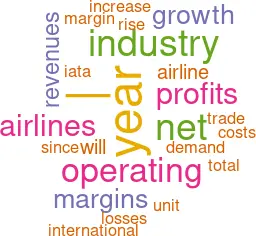Airline Industry: demand and
profitability under pressure
June 2019


IATA presented its midyear economic update of the global airline industry at its AGM at the beginning of June (held this year in Seoul). Traffic in 2018 looks to have grown by 7.4% in RPK terms continuing a strong above-trend rate of 6% a year since the last peak in 2008. However, the industry association slashed its forecasts for profitability by 27% for 2019 — the fifth year of profits' decline since the 2010 peak. Should the industry expect a cyclical downturn?
In 2018 the industry generated an increase in revenues of 7.6% on the back of a 6.1% increase in capacity. Passenger load factors continued to rise, up by 0.4 percentage points to a record 81.9%. Unit revenues rose helped by a 12% jump in cargo yields — total revenues increased by nearly 8% to $812bn — but airlines could not fully recover the increase in fuel costs. Oil prices increased — Brent Crude averaged $71.6/bbl in the year up by 30% from $54.9 in the prior year — and total costs were up by 9.6% year on year. Operating profits for 2018 reached $47bn representing a margin of 5.8% but were 17% down from the level achieved in 2017 — and 15% below IATA’s estimate made in December 2018. Net profits are estimated at $30bn down from $37.6bn in the previous year, reflecting a 3.8% margin.
Results by region (of airline establishment) vary considerably. North American airlines, reflecting the consolidation that has taken place in the USA, generated operating margins of over 9%, and produced $15bn in net profit — more than half the industry total.
European airlines saw operating margins decline to 6.2% from 7.9% and net profits of $8,1bn down from $9.4bn, while for airlines in the Asia/Pacific region operating margins fell by 180bp to 4.5% and net profits by $1.7bn to $6bn.
In the Middle East however, there was another year of operating losses as the combination of overcapacity, intense competition and US Dollar strength took its toll: operating margins are estimated at -2% and net losses of $1bn. (Emirates itself, the world’s largest international carrier, in May announced a 70% fall in net profits to a modest $237m for its year ended March 2019 — a margin of 0.9%.)
Airlines in Latin America faced a mixed environment — improving conditions in Brazil but deterioration in Argentina and elsewhere. Operating margins fell by 3.5 percentage points to 2.7% and net losses approximated $(0.5)bn.
Key elements for the 2019 outlook is what real impact the US trade wars will have, and whether unit revenues could rise to cover cost increases.
International trade growth has slumped since Donald Trump’s imposition of tariffs on Chinese trade; and there has been a sudden slowdown in international freight traffic. In the face of softening world economic growth IATA is forecasting airline capacity growth of only 4.3% (down from 6.1%), passenger demand growth of 5% — with some sharp declines in growth rates in Asia and the Middle East (see chart) — and a flat cargo performance. Recent announcements from the European airlines seem to show that there is a growing sign of demand weakness (while renewed tensions in the Gulf will not help), suggesting that unit revenues will once again not rise sufficiently to cover costs.
For the full year IATA is forecasting industry operating and net profits down by 7% at $43.6bn and $28bn respectively, with reductions in all areas except for North America (see chart). It notes that on its forecasts the industry could for the fifth consecutive year produce shareholder returns above the cost of capital “but only just”. The trouble with looking at such a measure for an industry in aggregate is that it fails to recognise that some owners regard that there be greater importance to provide benefits to stakeholders other than shareholders. As a high growth commodity business perhaps zero net margins are the long term norm.
Aléxandre de Juniac (IATA’s DG and CEO) said “the good news is that airlines have broken the boom-and-bust cycle". This may suggest to the cynical that we are due a downturn: but it will be caused as usual by an external shock.
Source: IATA
Note: reflects monetary difference between return on capital employed and weighted average cost of capital